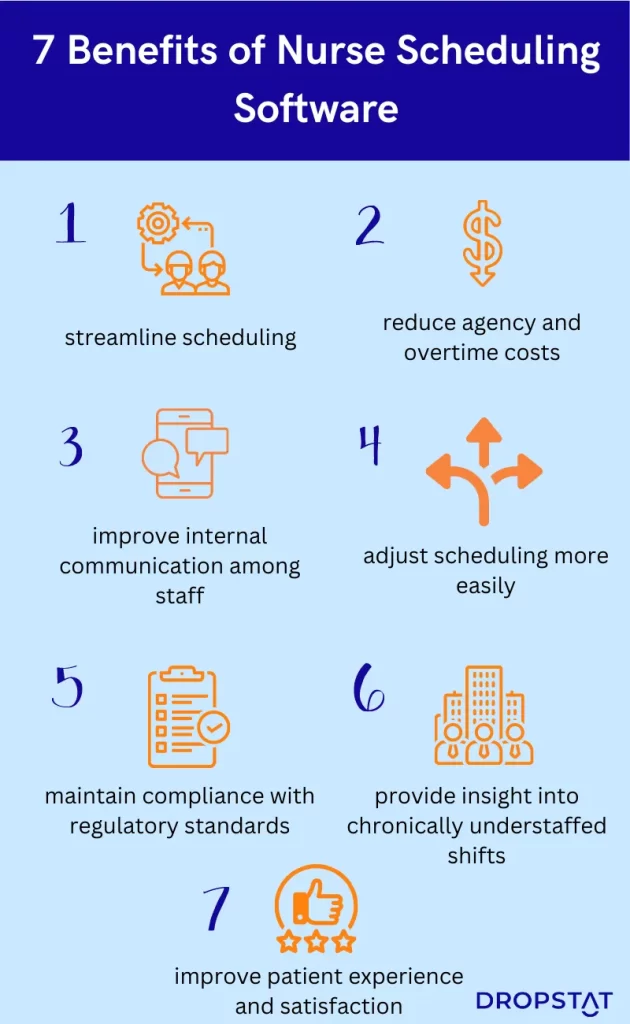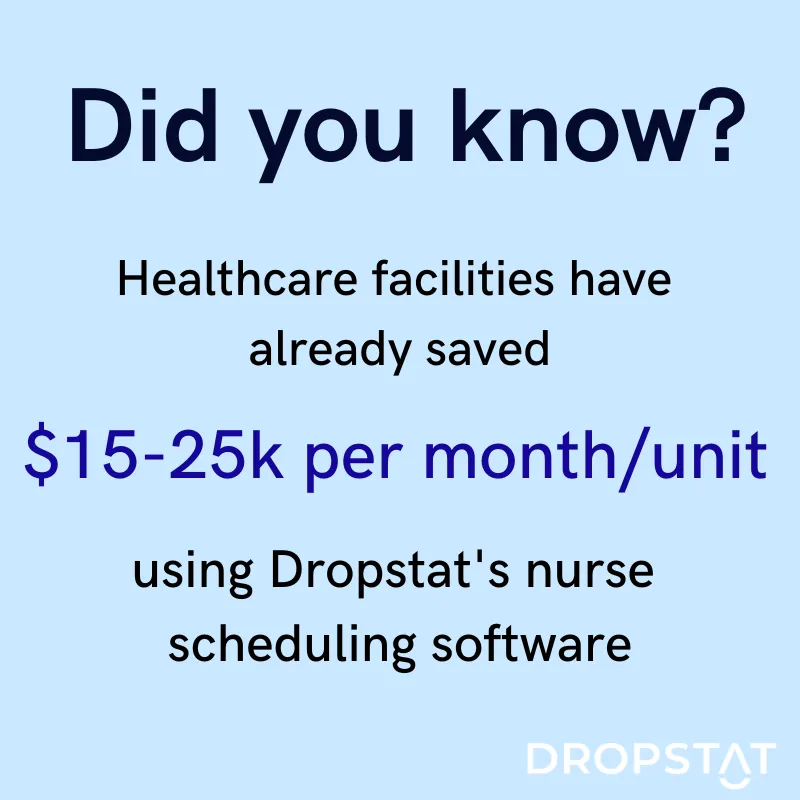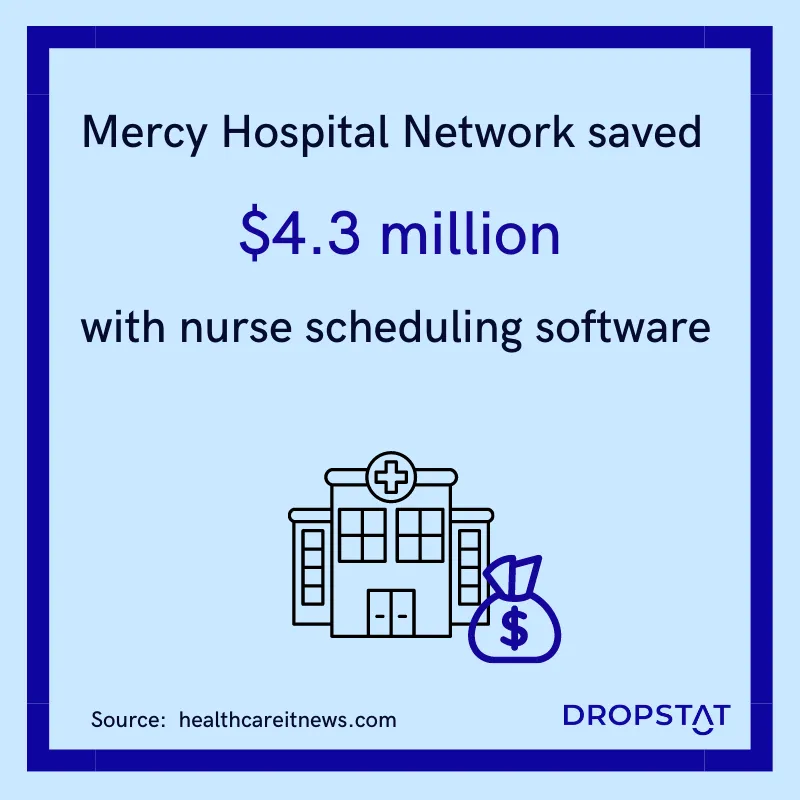How does nurse scheduling software work?
Scheduling software that is used within healthcare facilities helps integrate employee data to meet organizational demands. The software uses time-embedded communication platforms alongside time tracking and shift management to automate scheduling. This provides a baseline for administrators and schedulers to optimize employee schedules.
When scheduling technology hosts employee data such as experience, seniority, and previous shifts picked up by each staff member, workforce management and administrative tasks become faster, more reliable, flexible, and cost-effective. Healthcare scheduling software also allows administrators to manage scheduling preemptively to account for schedule adjustments and fluctuations in a facility.
Proactive scheduling enables your facility to be braced for the continuous changes within the institution and among multiple departments. Using employee scheduling software also gives administrators a better picture of their current staffing and open shifts.
Benefits of investing in a nurse schedule app
Although healthcare scheduling software provides significant benefits for your healthcare facility, it does require an initial investment of both funding and employee mindset. However, some of the advantages include the following:
- streamline the internal scheduling process to improve efficiency
- reduce agency and overtime costs
- improve internal communication among staff
- adjust scheduling more easily
- maintain compliance with regulatory standards
- provides insight into shifts that regularly lack permanent staff – improves the allocation of funds
- better patient experience and satisfaction

Streamline scheduling
When schedulers and administrators utilize software to complete the majority of scheduling, more time can be used to focus on quality improvement in other areas of operations, such as reducing patient wait times. Scheduling software considers staff availability to create better shift-filling practices that drive down costs.
Reduce agency and overtime costs
When your healthcare facility invests in employee scheduling software, it becomes more evident when overtime and agency use are commonplace. The accessible data and patterns in scheduling practices can also serve as a basis for recognizing a deficit in specific nursing staff roles. By seeking out full-time employees to fill the demands rather than relying on agency staff regularly, staff can build a stronger care team while reducing excess costs.
Easy scheduling adjustments
Since nurse scheduling software can be updated in real-time, administrators have more control over trading and adjusting shifts. With greater flexibility in scheduling, nursing staff can commit to a better work-life balance and reduce stress around working shifts that do not align with their personal responsibilities. This, in turn, aids in a better employee experience, employee engagement, and retention.
Maintain compliance with regulatory standards
Understaffing is a clear sign of inefficient facility operations. With the increased ability to view gaps in shift demands and nursing roles across units and departments, facilities are better equipped to comply with regulatory standards. This also ensures optimal patient safety and a better public hospital image and ranking.
Improve hiring efforts
Using advanced nurse scheduling software can illuminate where your facility is lacking in specific healthcare roles, which provides more specific and useful insight into the hiring process. This also enables hiring managers to construct the hiring process in a more focused and intentional way which reduces inefficiencies that are associated with hiring the wrong employees.

Increase patient satisfaction and experience
Providing employee scheduling software for your facility reduces the likelihood that patient volume will overwhelm your nursing workforce. Schedulers can take advantage of the ability to ensure adequate staffing, which leads to improved wait times, and ample time with their healthcare team, establishing higher thresholds of patient experience and satisfaction.
What should facilities consider when choosing a nurse scheduling software?
- The management team needs
When investing in nurse scheduling software, your management team’s needs should be a top priority. The main concern with scheduling is reducing costs while providing sufficient staffing levels through workforce management.
- Staff needs
Another point of concern with determining the ideal scheduling software is the demands of your healthcare workforce. Optimal scheduling takes your employees’ schedules into consideration through flexible shift assignments while limiting overtime to prevent burnout and avoidable costs.
- Patient needs
Above all, deciding on a scheduling software should cater to the patient care demands of your facility. The right software can oversee shift coverage between units and departments to confirm that staffing levels meet patient volume demands to reduce wait times. Additionally, guaranteeing that your facility is decreasing role inefficiency by calculating where departments are lacking or are overstaffed in advanced-skilled nurses and supporting nursing roles will create a more effective and cohesive care team for your patients.

How to choose a nurse scheduling app
Some points to consider when determining which schedule software would be most effective for your healthcare organization are:
- whether the platform will include training for administrators
- whether or not the scheduling software can support the primary issues of your operations (i.e. excess overtime, inadequate nurse-patient ratios…)
- if the scheduling technology includes a communication platform to keep teams in contact
- if the software can accommodate schedule changes easily
- whether the software can control costs
Why Dropstat is the best nurse scheduling software for your facility
While there are many scheduling software options to choose from, Dropstat is tailored to meet a wide variety of demands for a healthcare organization.
Dropstat provides ongoing project management support, ensuring that your administrators can access support 24/7 to take advantage of all of the platform’s functions and seamlessly integrate it into their facility’s operations. Learning new software may be intimidating at first, so Dropstat provides unique continuous assistance to each facility according to their needs to understand the software’s features.
Being a gap shift management platform, it employs internal teams to cut down on overtime and agency use which also reduces costs. By automating a baseline schedule and flagging staff and shifts that may not be most efficient, Dropstat’s software provides the tools to build the ideal schedule for your healthcare team and your patients to improve health outcomes.
These factors all support Dropstat’s ability to control costs by providing greater transparency into operations and ultimately improving patient and nurse satisfaction metrics.







